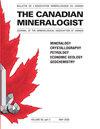Ultramafic xenoliths from the 1.15 Ga Certac kimberlite, eastern Superior Craton
IF 1.5
4区 地球科学
Q3 MINERALOGY
引用次数: 1
Abstract
Xenoliths and xenocrysts of mantle material from kimberlite dikes located underground at the Certac Au mine, Québec, in the eastern Superior Craton, were studied in terms of the major element composition of their constituent minerals. The kimberlite was dated at 1151 ± 46 Ma by the U-Pb perovskite method. This suite thus provides a rare glimpse into the Mesoproterozoic mantle of the Superior Craton. Two parageneses of mantle material unrelated to the kimberlite magmatism occur: (1) an olivine + ilmenite ± magnetite association characterized by relatively Fe-rich olivine (Mg# = 0.68–0.84) and ilmenite enriched in Mg and Cr (4–13 wt.% MgO, Cr2O3 up to 3 wt.%), and (2) spinel peridotite characterized by Mg-rich olivine (Mg# = 0.91–0.94). The Fe-rich association is interpreted as a magmatic cumulate likely unrelated to the kimberlite. No mantle-derived garnet occurs in the xenoliths or as xenocrysts. The presence of Cr-rich spinel (Cr# = 0.84–0.98) in high temperature (860–953 °C) chromite peridotite indicates bulk compositions too depleted in Al for garnet to be stable, although geothermometry suggests they equilibrated at depths corresponding to garnet stability (90–131 km, depending on the geothermal gradient). Alternatively, the presence of phlogopite in two of the three high temperature (i.e., deepest) chromite peridotites suggests the absence of garnet and presence of low-Al chromite may have been caused by metasomatism from a K-rich fluid that replaced garnet with phlogopite + clinopyroxene ± chromite. Less depletion at shallower depths is indicated by a chromite (Cr# = 0.60) dunite that equilibrated at 831 °C and a low temperature (752 °C) Mg-Al-spinel lherzolite.苏必利尔克拉通东部1.15 Ga Certac金伯利岩的超镁铁质捕虏体
根据其组成矿物的主要元素组成,研究了位于苏必利尔克拉通东部魁北克Certac金矿地下的金伯利岩岩脉中地幔物质的捕虏体和捕虏晶体。用U-Pb钙钛矿法测定了金伯利岩的年龄为1151±46Ma。因此,这一套提供了对苏必利尔陨石坑中元古代地幔的罕见一瞥。出现了两种与金伯利岩岩浆作用无关的地幔物质共生体:(1)橄榄石+钛铁矿±磁铁矿组合,其特征是相对富铁的橄榄石(Mg#=0.68–0.84)和富含Mg和Cr的钛铁矿(4–13 wt.%MgO,Cr2O3高达3 wt.%),和(2)以富镁橄榄石为特征的尖晶石橄榄岩(Mg#=0.91–0.94)。富铁组合被解释为可能与金伯利岩无关的岩浆堆积体。捕虏体或捕虏晶体中不存在地幔衍生的石榴石。在高温(860–953°C)铬橄榄岩中,富铬尖晶石(Cr#=0.84–0.98)的存在表明大块成分的铝含量太低,石榴石不稳定,尽管地热测量表明它们在对应石榴石稳定性的深度(90–131 km,取决于地热梯度)达到平衡。或者,三种高温(即最深)铬橄榄岩中有两种存在金云母,这表明石榴石的缺失和低铝铬铁矿的存在可能是由富钾流体的交代作用引起的,该流体用金云母+斜辉石±铬铁矿取代了石榴石。在831°C和低温(752°C)Mg-Al尖晶石二辉橄榄岩下平衡的铬铁矿(Cr#=0.60)重晶石表明,较浅深度的贫化较少。
本文章由计算机程序翻译,如有差异,请以英文原文为准。
求助全文
约1分钟内获得全文
求助全文
来源期刊

Canadian Mineralogist
地学-矿物学
CiteScore
2.20
自引率
22.20%
发文量
45
审稿时长
4-8 weeks
期刊介绍:
Since 1962, The Canadian Mineralogist has published papers dealing with all aspects of mineralogy, crystallography, petrology, economic geology, geochemistry, and applied mineralogy.
 求助内容:
求助内容: 应助结果提醒方式:
应助结果提醒方式:


